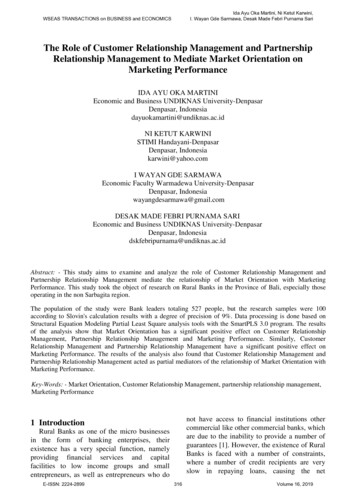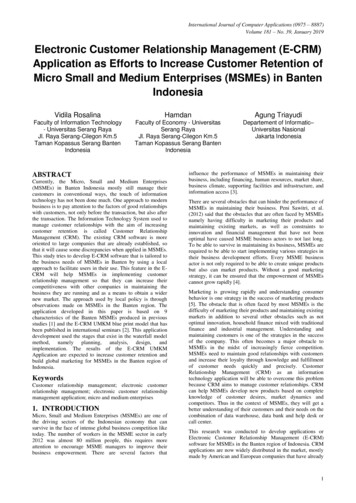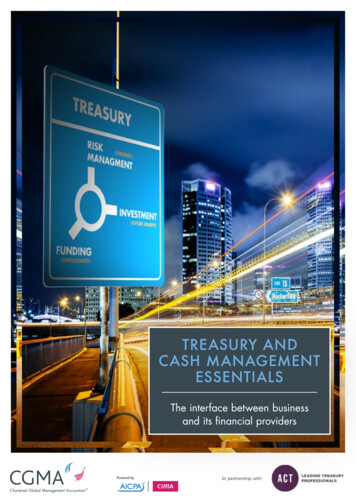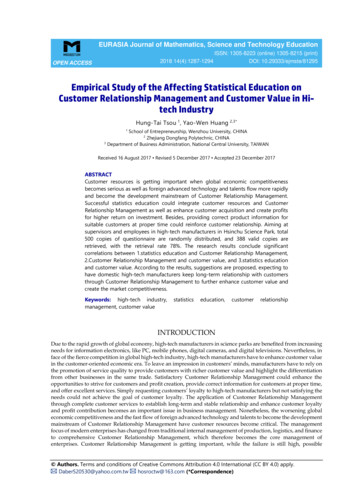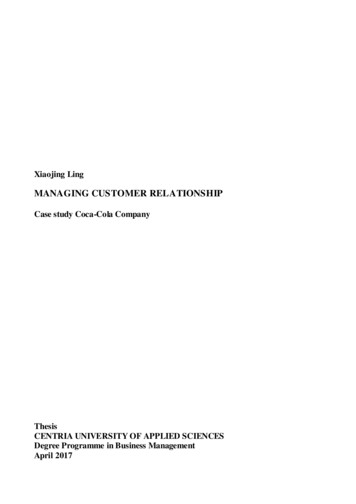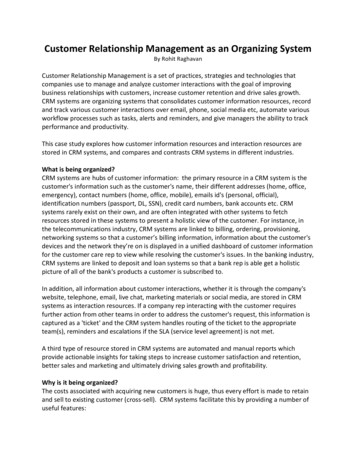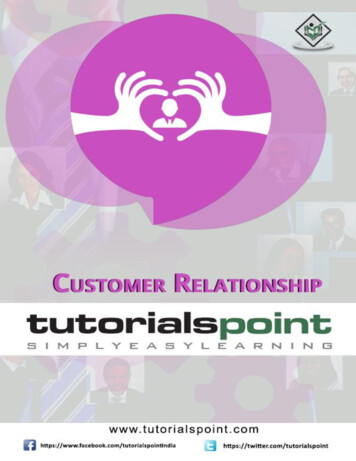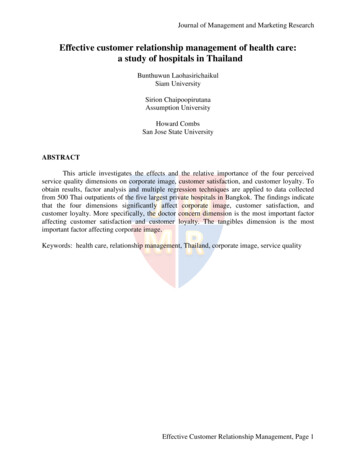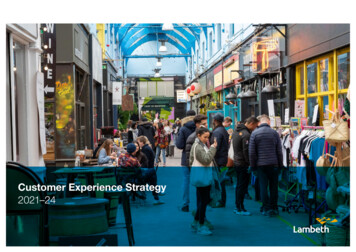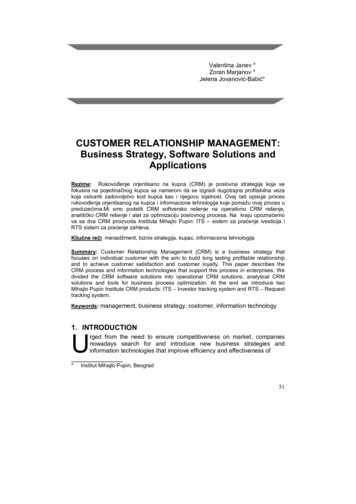
Transcription
Valentina Janev *Zoran Marjanov *Jelena Jovanović-Babić*CUSTOMER RELATIONSHIP MANAGEMENT:Business Strategy, Software Solutions andApplicationsRezime: Rukovođenje orjentisano na kupca (CRM) je poslovna strategija koja sefokusira na pojedinačnog kupca sa namerom da se izgradi dugotrajna profitabilna vezakoja ostvariti zadovoljstvo kod kupca kao i njegovu lojalnost. Ovaj rad opisuje procesrukovođenja orjentisanog na kupca i informacione tehnologije koje pomažu ovaj proces upreduzećima.Mi smo podelili CRM softversko rešenje na operativno CRM rešenje,analitičko CRM rešenje i alat za optimizaciju poslovnog procesa. Na kraju upoznaćemova sa dva CRM proizvoda Instituta Mihajlo Pupin: ITS – sistem za praćenje ivesticija iRTS sistem za praćenje zahteva.Ključne reči: menadžment, biznis strategija, kupac, informaciona tehnologijaSummary: Customer Relationship Management (CRM) is a business strategy thatfocuses on individual customer with the aim to build long lasting profitable relationshipand to achieve customer satisfaction and customer loyalty. This paper describes theCRM process and information technologies that support this process in enterprises. Wedivided the CRM software solutions into operational CRM solutions, analytical CRMsolutions and tools for business process optimization. At the end we introduce twoMihajlo Pupin Institute CRM products: ITS – Investor tracking system and RTS – Requesttracking system.Keywords: management, business strategy, costomer, information technology1. INTRODUCTIONUrged from the need to ensure competitiveness on market, companiesnowadays search for and introduce new business strategies andinformation technologies that improve efficiency and effectiveness of*Institut Mihajlo Pupin, Beograd51
V.Janev,Z.MarjanovJ.,Jovanović-BabićCUSTOMER RELATIONSHIP MANAGEMEN business processes and decision support. According to Balanced ScorecardsMethodology [9], a well established methodology for measuring enterpriseperformance, customers and position on market along with internal processes,financial results and organizational learning and growth are main indicators forcompany success. Thorough studies of customer’s profitability have shown that(1) it is five to ten times more expensive to acquire a new customer than to sell aproduct to a loyal customer; and (2) only 20% of customers generate 80% ofprofit. Therefore, one of the main business activities in companies isestablishment of organizational culture and information infrastructure for efficientmanagement of profitable customers.Customer Relationship Management (CRM) is a business strategy that focuseson individual customer with the aim to build long lasting profitable relationshipand to achieve customer satisfaction and customer loyalty. CRM is a process oflearning the customer attitudes and preferences and according to thatcustomizing the products and services to best suit their needs. Successfulimplementation of the process requires tight integration of the front end activities(marketing, sales and service activities) with the back end activities, such asmonitoring, planning and decision support. Information infrastructure that enablethe process is build of operational CRM solutions (business contactmanagement tools, sales automation tools, direct marketing tools), analyticalCRM solutions (data mining algorithms, information warehouse,on-lineanalytical processing technologies), as well as tools for business processoptimization.The objectives of this article are to define the customer relationshipmanagement process, overview the main features of commercial available CRMtools, and to discuss the Mihajlo Pupin Institute CRM offer. Topics are presentedin Section 2, Section 3 and Section 4 consequently.2. CRM PROCESSCustomer relationship is based on a cycle of contacts that customer has withcompany (see Figure 1, Copyright SAS Institute). A cycle starts when apotential customer express his interest in company offer by browsing its WEBpresentation, or contacting the company’s representatives by phone, e-mail orpersonally. Just a small number of initial contacts develop in sales activity.Depends on the type of product or service, sales process could last many daysor months, or even years. When a sales activity concludes with a sale, thepotential customer became a customer. With the time, through communicationwith the company and by using the company’s products, the customer gains animpression about the company. This relationship could develop in two directions.If the customer is satisfied with the company offer, he continues to buy the sameproduct or extend his necessities to other products and became a loyalcustomer. Otherwise, he will be a lost customer.52
Industrija 1-2/2004Often the marketing, sales and client service activities in enterprises are notaligned to serve the customer’s needs, but rather are organized aroundproducts. As a result, the profitability analysis is based on profitability ofindividual products instead of profitability of customers. The objectives ofcustomer relationship management strategy are to transform the existingproduct oriented processes to client oriented processes and to optimize theclient process defined above. This is possible with transparent and coordinatedactivities of all departments.MANAGEMENTMARKETINGCUSTOMERCUSTOMER SUPPORTSALESFigure 1: The CRM process.Marketing’s role is to generate demand. On one side, that means reachingpotential customers to make them aware of the company’s products andservices, following up with requested information, and turning over qualifiedleads to the sales department. On the other side, marketing analyst do anextensive market research, customer segmentation, preference analysis,campaign effectiveness analysis, retention analysis, etc. The job of sales is toconvert qualified leads into revenue. Effective selling methodologies rely onstructured processes with multiple steps and milestones involving many differentpoints of contact. Thus, CRM software must allows total visibility of thecustomer’s history and provide an opportunity management system capable oforganizing and tracking the processes. Also, CRM software should performsales performance analysis and profitability analysis. Closing the sale is just thebeginning of the customer relationship. Customer satisfaction and loyalty are53
V.Janev,Z.MarjanovJ.,Jovanović-BabićCUSTOMER RELATIONSHIP MANAGEMEN largely determined by the responsiveness of customer service and support.Therefore, first line support agents should be online connected with acomprehensive knowledgebase that enable quick and effective resolution ofcommon requests.The role of management is to focus on big picture of the process, analyze theexisting process and introduce strategy that will reward the best clients toimprove loyalty, re-activate dormant clients, increase share of client spend bycross sale, reduce the cost of acquisition, marketing and serving low valueclients, increasing contact with occasional clients, etc.3. MAIN FEATURES OF COMMERCIAL CRM TOOLSWe have divided the CRM market into: (1) operational CRM solutions thatautomate the everyday customer activities, (2) analytical CRM solutions thatperform deeper analysis of customer behavior and are used for buildingcustomer strategy, planning further activities and decision support, and (3) toolsfor business process optimization that monitor the customer process and areused in process re-design and optimization. Key players on market foroperational CRM solutions are the following software providers: IBM, ORACLE,SAP, Siebel, PeopleSoft for large systems and Front Range Solutions,Chordiant, E-piphany and others for midmarket and small systems. Bestanalytical CRM solutions are provided by SAS, IBM, SPSS, Cognos, BusinessObjects and others. Business process optimization market prevail Ultimus,Staffware and QPR. Often in practice, CRM process is based on integration oftools from different providers. On Figure 2 (Copyright Cognos, [1]) Siebeloperational CRM solution is integrated with Cognos CRM analysis and reportingtools. In the following subsections we present main features of commerciallyavailable CRM tools.Figure 2: Integration of commercial CRM solutions.54
Industrija 1-2/2004Operational CRMFront end activities are: communication with the customers via telephone, fax,WEB, completing customer’s requests for financial transaction, servicingactivities such as distributing goods to customers, etc. We will refer to theseactivities as operational and software tools that support them operational CRMtools. Operational CRM tools include: business contact management (BCM)systems, sales force automation systems (SFA), answering machines, callcenters, knowledge portals, e-marketing applications, bank automates, etc. BCMtools enable auto-dialing, order entry, scheduling callbacks and other follow-upactivities (meetings, e-mails, and other messages), insight in client history, etc.SFA tools enable complete pipeline management, tracking the sales process forindividual account, reporting on financial results and forecasting the future sales.Marketing automation tools facilitate leads generation and tracking, preparationof marketing information; execution of marketing campaigns, etc. Call centersand self-service knowledge portals, from one side, help the customers to easierfind the needed information, and from the other side, help the technical staff tocomplete the customer’s requests promptly.Operational CRM systems generate a vast amount of data that usually reside ondifferent locations (platforms), in different formats and data/business models. Inthat way, there are islands of data in enterprises and reporting from thesesources could give misleading information. In order to get a complete view ofthe customer the data sources have to be integrated in a form of informationwarehouse. Information warehouses open possibilities for extensive research ofcustomer business behaviors. Hence, with time, analytical CRM techniquesappear on market that are nowadays essential part of CRM solutions.Analytical CRMAnalytical CRM aims to monitor the ways clients do business, understand theclient’s needs and preferences, predict the clients future behavior, identify themost prospective customers, analyze the marketing and sales activities anddirect the future actions. Analytical CRM process is composed of two subprocesses: (1) process of transformation of customer data into valuablecustomer information that is stored in data or information warehouse, and (3)process of analysis of customer data.Data warehousing tools that support data warehousing process include: Tools for data transformation (data extraction from transactionalsystems, data cleaning, data integration and processing and dataloading in format suitable for further analysis). Administration tools (defining metadata, automation and schedulingprocesses) and security system Reporting tools that comprise OLAP tools, too.55
V.Janev,Z.MarjanovJ.,Jovanović-BabićCUSTOMER RELATIONSHIP MANAGEMEN OLAP stands for on-line analytical processing and enable multidimensional viewof customer data. Using drill-down action the data could be analyzed fromsummary level to most detailed levels. Levels and dimensions are defined tobest suit the analysis and reporting purposes. Multidimensional cubes that arebuilt on time data are used for analysis of trends. For example, sales activitiesare analyzed through time across geographical and organizational hierarchydimension.“Data mining” is a process of analysis of large quantity of data with the aim touncover hidden patterns and rules of customer behavior. Depending on theanalysis problem, used techniques and quality of input data, a specific businessmodel is built that either explains, categorize or forecast.By incorporating the business model back into operational applications, decisionmaking process could be automated. Sales and marketing applications of datamining are: credit scoring, campaign analysis, customer segmentation andprofiling, profitability analysis, analysis of communication channels, identificationof loyal customers, estimating the customer lifetime value, insurance risk, claim,and fraud analysis, etc. Core technologies for data mining are statistics, timeseries analysis methods and forecasting algorithms, rule based systems, neuralnetworking, machine learning, artificial intelligence, etc.Business process management toolsEnterprises have realized that business processes together with customerpotential, product market, knowledge and skills of employees are valuableintangible asset of the company. The objectives of business processmanagement (BPM) are to identify the business processes on corporate level,integrate, automate and optimize them where ever is that possible. Optimizationof client processes improves business performance by reducing costs andenhancing customer satisfaction. Nowadays optimization of business processesis considered as a precondition for business success.As was presented in previous section, client processes are spread across manydepartments. As first the client interests are registered in marketing department,sale transaction is carried out in financial department, product is delivered bytransportation personal, further client requests are served in call center andtechnical support group, etc. Some transactions could be executed automatically(for example buying goods by Internet or searching the company’s knowledgeportal), but some steps require presence of company representative. Sometimesthese activities are carried out by different persons by using different softwareapplications that reside on different platforms. BPM software tools provide theability to define and build a model of best practice, integrate and automate theindividual activities in standardized customer process. Process automation takescare of routine activities such as call scheduling or information fulfillment, andlets account representatives focus on substantial issues.BPM tools use statistical modeling techniques to analyze the process behaviorunder various scenarios modeling real business conditions. Analysis of the56
Industrija 1-2/2004modeled process leads to a better understanding the business operations,critical flaws in the current operational conditions, ways of optimizing them, andan assessment of the resources required to ensure performance consistent withexpectations. Results from these analytical activities have often resulted in 50 to80% improvement in operational efficiency and process improvement [4,5]. BPMtools ensure optimal utilization of recourses and improved businessperformance.4. MIHAJLO PUPIN INSTITUTE CRM PRODUCTSMihajlo Pupin Institute started research in the field of customer relationshipmanagement two years ago as part of the research of knowledge managementsolutions on market. Knowledge management as management discipline is mostoften defined as a process of creating value from the intangible assets of thecompany. From that viewpoint, customer relationship management systemsgenerate new knowledge about customers. In parallel with the research, abusiness contact management product (ITS – Investor tracking system) and aprototype application for tracking customer requests (RTS – request trackingsystem) was developed. The following subsections discuss ITS and RTS.ITS – Investor Tracking SystemFigure 3: ITS – Investor Tracking System.ITS application (on Figure 3) automate the communication processes withinvestors, suppliers, partners and clients and efficiently track all type of contacts(meetings, e-mail and fax messages, telephone calls). Although there arecommercially available products that could be used for this purpose (for exampleGoldMine from Front Range Solutions), ITS development was initiated to57
V.Janev,Z.MarjanovJ.,Jovanović-BabićCUSTOMER RELATIONSHIP MANAGEMEN respond to the following specific needs of the Ministry of International EconomicRelations. As first, the system is intended to track sensitive information aboutforeign investors stored in code pages used in Serbia (Windows 1251 orWindows 1250 for Serbian Cyrillic and Serbian Latin respectively). And second,the system should satisfy the data security and information access standards ofthe government institutions in Serbia. The search problem was solved byfunction that translates the information into English Latin. Regarding security, thefollowing types of security were implemented: hierarchical authorization forusers, hierarchical authorization for document types, protection from incidentaldata erase or data change, and protected of connection (HTTPS protocol).Besides tracking documentation and information about correspondents andparticipants at meetings, the system is used for planning the follow-up activities,routing the uncompleted activities and for reporting. Investitor Tracking System(ITS) is implemented as WEB based application in three-tier architecture (seeFigure 4) using Microsoft Visual Studio development environment, MicrosoftSQL Server 2000 and Microsoft IIS. More information about the implementationcould be found in [6].RTS – Request Tracking SystemClient tierMiddle tierBack tierIE 5.5 or higherASP.NETC#HTTPSRTSITSIE5.5IE 5.5IE 00HTTPSHTTPSIISFirewallAdministrationFigure 4: ITS/RTS three tier architecture.RTS is pilot version of a system for tracking customer requests from the point ofentry in a company with complex organizational structure until its completion.Request processing is done in different departments spread out in manybranches. System was designed according to the requirements of Serbia LocalGovernment Reform Program forRequest/Document Tracking Solution forCitizen Assistance Canters. The objectives were to replace the current way ofprocessing citizen’s requests (inquiries, complaints, etc) in municipals in Serbiathat is done mostly on department basis with a new customer oriented solution.The proposed RTS solution offers: a single entry of customer request (andcustomer data) accompanied with a single case number, assignment of therequest to the appropriate departments according to previously standardized58
Industrija 1-2/2004procedures, use of dynamic lists of follow-up activities and responsible persons,tracking the request until its completion, information about the status of therequest via answering machine, and issuing receipt or proof of completion at theend of the procedure.The proposed solution operates on Windows operating system. RTS isWEB based application, implemented in three-tier architecture usingMicrosoft Visual Studio development environment, Microsoft SQL Server2000 and Microsoft IIS (see Figure 4). More information about the solutionis written in [3].5. CONCLUSIONCustomer relationship management (CRM) initiatives are most often driven bystrategic planners with the objectives to gain customer knowledge, servecustomers, improve their loyalty, profitability and satisfaction, meet the businessobjectives, be competitive on the market, and create profit. Implementation ofCRM strategies requires transformation of existing internal processes towardsclient oriented processes, changes in organizational culture and informationinfrastructure.In this article we observe CRM is a process of integration and optimization ofcustomer activities in marketing, sales, customer support and management. Wedivided the CRM software tools into operational CRM tools, analytical CRM toolsand tools for business process management. Operational CRM tools enableefficient communication with clients and automate the client processes. Theseinclude business contact management tools, sales automation tools, directmarketing tools, e-marketing, call centers, etc. Analytical CRM solutions thatperform deeper analysis of customer behavior and are used for buildingcustomer strategy, planning further activities and decision support. AnalyticalCRM tools are based on data mining algorithms, information warehouse, on-lineanalytical processing technologies, forecasting and other statistical algorithms.Business process management tools monitor the customer process and areused in process re-design and optimization.At the end, we introduce two CRM applications developed at Mihajlo PupinInstitute. ITS – Investor Tracking System could compete with commercialproducts for business contact management. Its advantage is that it fully supportswork with Serbian Cyrillic and Latin letters and offers high level of security. RTS– Request/Document tracking System is a pilot application that allowsstandardization of customer processes and tracking requests in complexorganizations.59
V.Janev,Z.MarjanovJ.,Jovanović-BabićCUSTOMER RELATIONSHIP MANAGEMEN 6. REFERENCES[1] Camilucci L., “Best-Of-Breed CRM with Cognos and Siebel”, Copyright 2002Cognos, http://www.cognos.com.[2] “Customer Management - Background and Information on Customer ManagementSolutions”, Copyright 2002 FrontRange Solutions Inc., http://www.frontrange.com.[3] Jovanović Babić J., “Request Tracking System – Functional Specifications”, InstitutMihajlo Pupin, 2003.[4] Khan R., Little T.A., “Understanding Business Process Modeling & Analysis: The FirstStep to Achieving Breakthroughs in Productivity Improvements”, A Ultimus White Paper,Copyright 2002 Ultimus, Inc., http://www.ultimus.com.[5] Koistinen T., "Combining Balanced Scorecard and Process Management: BusinessActivity Monitoring", Copyright QPR Software Plc, http://www.qpr.com.[6] Marjanov Z., Jovanović Babić J., Pejakov D., “ITS – Sistem za praćenje kontakata”,XVIII Naučno stručni skup – InfoTech2003, Vrnjačka Banja.[7] “Microsoft CRM Product Architecture”, White Paper, Copyright 2003 Microsoft,http://www.microsoft.com.[8] “Implementingthe Customer Relationship Management Foundation – AnalyticalCRM”, A SAS White Paper, Copyright SAS Institute Inc., http://www.sas.com.[9] Yeich P., Zeid A., "From the Tactical to the Strategic, Transforming Data intoKnowledge for use in an Enterprise Performance Management System", SAS InstituteInc., Cary, NC., 2002.60
Summary: Customer Relationship Management (CRM) is a business strategy that focuses on individual customer with the aim to build long lasting profitable relationship and to achieve customer satisfaction and customer loyalty. This paper describes the CRM process and information technologies that support this process in enterprises.
